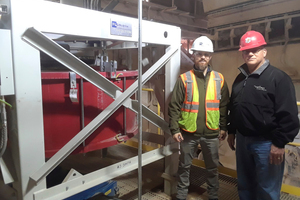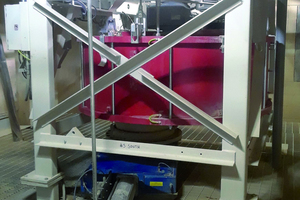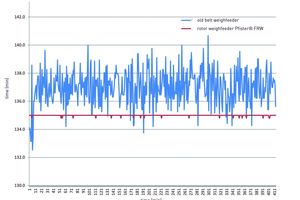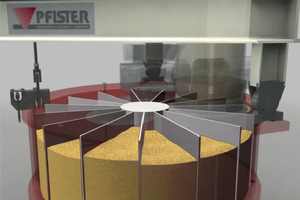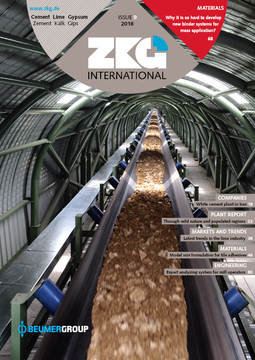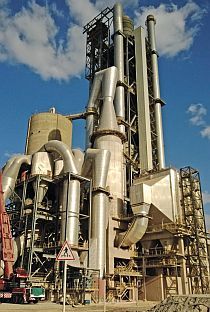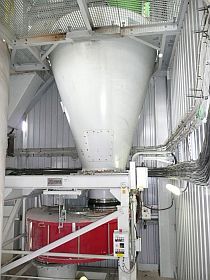Improving kiln stability at The Monarch Cement Company
Although many factors contribute to producing consistently high‑quality cement for an attractive return on investment, the equipment employed is probably the most crucial component. Pfister gravimetric dosing equipment can boost efficiency in cement production. US-based The Monarch Cement Company recently updated its kiln feeding systems by replacing belt weighfeeders with Pfister rotor weighfeeders. The result is a 5 % improvement in dosing accuracy and considerably better kiln stability.
The Monarch Cement Company operates two kilns with preheater/precalciner at its main site in Humboldt, KS/USA, with a current output of 1 million t/a of Portland and masonry cement. To achieve consistently high‑quality clinker, kiln stability is of utter importance. Kenny Miller, Vice President of Cement Manufacturing at Monarch Cement, recognized the need to stabilize the raw meal feed into the preheater. “We had constant accuracy issues with belt weighfeeders, involving lack of kiln and tower stability,” Miller explained.
The US cement producer had previously installed Pfister dosing equipment, specifically rotor weighfeeders for dosing pulverized coal. So Miller consulted this supplier again for a solution for modifying both the plant’s kiln feed lines. A Pfister FRW rotor weighfeeder was identified as the system of choice for dosing the raw meal. Thanks to The Monarch Cement Company project team’s helpful collaboration, it was possible to design and integrate a suitable layout within the limited space available for two new Pfister FRW 4.18 rotor weighfeeders, each of which now serves one preheater/precalciner line (Figure 1).
At The Monarch Cement Company, free-flowing raw meal with a humidity of less than 1 % is dosed at a feed rate of up to 180 t/h and an ambient temperature range between -20 and +50 °C. Its density ranges from 0.6 to 0.8 t/m³ at a maximum temperature of 90 °C (Figure 2).
Matthew Thompson, Senior Sales and Project Manager, managed the construction project. “At The Monarch Cement Company,” he says, “we faced the challenge of fitting the new state‑of‑the-art equipment into an existing layout designed for belt weighfeeders. We were able to arrange the new equipment and modify the existing bin discharge while keeping the existing platforms with only minimal structural stiffeners.”
“Belt weighfeeders,” reports Miller, “ are supposed to have 0.5-1 % accuracy, but in practice, they only achieve 3-8 % accuracy due to material buildup, dedusting, ventilation, and the condition of such wear parts as pulleys, bearings, and belting. They require a significant amount of maintenance, are harder to calibrate, and can cause loss of production time in the event of a belt failure.”
Despite a higher initial investment, “the Pfister FRW rotor weighfeeder is almost maintenance free and produces substantially higher process stability, so the investment quickly pays off,” Miller affirms (Figure 3).
A combination of two mechatronic features enables Pfister equipment to feed fine-grained materials like kiln feed, additives or cement into mills with stable accuracy. “Pfister rotor weighfeeders are designed with an internal rotor wheel constructed of segmented chambers,” explains Thompson. “After the material is extracted from the silo and into the rotor weighfeeder, it is weighed and dosed while being transported to the feeder’s outlet. The number and size of the chambers inside the rotor are calculated and arranged according to the material to be dosed. The rotor body is suspended on two bearings forming an eccentric weighing axis that includes a load cell. The weighing axis is positioned eccentric to the rotor shaft and passes through the middle of the rotor inlet and outlet. The load cell mounted at the third suspension point gravimetrically weighs the material contained in the rotor wheel before it is discharged. This design, in combination with the Prospective Control Strategy ProsCon, is what makes the difference compared to other systems (Figure 4). The prospective control algorithm ProsCon ensures precise dosing by predicting the variation in flow rate caused by material density and flowability. Considering the set point and dynamic motion characteristics of the feeder, the necessary speed at the dosing point is calculated and adjusted at the prospective point before dosing.
Secondly, the speed of the rotor itself also is an important factor. While other feeders rotate at a rate of several hundreds of revolutions per minute, hence wearing out their bearings and housing while consuming excessive energy, the rotor of Pfister weighfeeders rotates at only 4-10 rpm. Combined with its specially designed and integrated low-pressure pneumatic transport, the rotor conveys the required amount of pulverized raw material into the heating area, keeping wear and energy consumption to a minimum.”
As the equipment was being upgraded, it was also possible to reduce the amount of power-consuming equipment: “Monarch now uses air-actuated equipment,” reports Thompson. “That reduced the overall power consumption of the retrofitted equipment. The dosing of raw meal into a continuous process requires a predictable and reliable material flow which can be adjusted precisely to achieve stable production.
Our new Pfister solution,” concludes Miller, “results in constant, stable feeding over both the short and long terms.”
//www.flsmidth.com" target="_blank" >www.flsmidth.com:www.flsmidth.com

